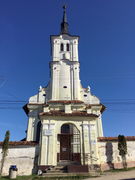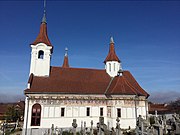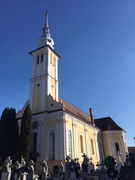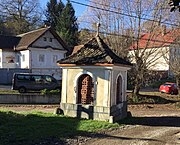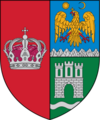Cernatu
History
The city since 1950 is composed of former villages which now form the main sectors: Baciu (Bácsfalu, Batschendorf), Turcheș (Türkös, Türkeschdorf), Cernatu (Csernátfalu, Zerndorf), and Satulung (Hosszúfalu, Langendorf). After the second half of the 11th century the villages were mentioned as "septem villae valacheles" (seven Vlach villages).
The first official mention of Săcele was a document issued on May 16, 1366, by the Hungarian King Louis I of Hungary in which he offers the area between the Timiș and Olt rivers to a trusted friend—Count Stanislav. Later it was under the Saxon management of Kronstadt (Brașov). Between the 13th and 14th centuries, an important Hungarian population settled in the region, marking the further development of the area.
During the Middle Ages three other villages belonged to the locality: Tărlungeni, Zizin, and Cărpiniș.
The Romanian name "Săcele" was first mentioned in a letter between the Wallachian Prince Vlad Călugărul (1482–1495) and the magistrate of Brașov. The Romanian etymology of "Săcele" is from "sătucele" meaning "small villages".
The German name was "Siebendörfen" which means "seven villages" and which is close to the Hungarian name "Hétfalu" or "Négyfalu". See also Seven Villages.
The inhabitants were the Mocani—local shepherds. They are mentioned in a few official documents and appear to have owned thousands of sheep, the villages being among the wealthiest in the area. They carried the local traditions across many Romanian lands due to the transhumance method of shepherding. Their customs exist to these days: the "Sîntilie" (Saint Elijah) festival, national costumes, etc.
After the Romanian Revolution of 1989, the city diversified its economy. In Săcele there are nowadays several small furniture factories, lumber-mills, as well as meat-packaging facilities.
Climate
Săcele has a warm-summer humid continental climate (Dfb in the Köppen climate classification).
| Climate data for Săcele | |||||||||||||
|---|---|---|---|---|---|---|---|---|---|---|---|---|---|
| Month | Jan | Feb | Mar | Apr | May | Jun | Jul | Aug | Sep | Oct | Nov | Dec | Year |
| Mean daily maximum °C (°F) | −0.3 (31.5) |
1.6 (34.9) |
6 (43) |
12 (54) |
16.9 (62.4) |
20.2 (68.4) |
22.1 (71.8) |
22.3 (72.1) |
17.4 (63.3) |
12.3 (54.1) |
7.1 (44.8) |
1.3 (34.3) |
11.6 (52.9) |
| Daily mean °C (°F) | −4.2 (24.4) |
−2.7 (27.1) |
1.5 (34.7) |
7.2 (45.0) |
12.3 (54.1) |
16 (61) |
17.8 (64.0) |
17.8 (64.0) |
13 (55) |
7.7 (45.9) |
3.1 (37.6) |
−2.3 (27.9) |
7.3 (45.1) |
| Mean daily minimum °C (°F) | −8.1 (17.4) |
−6.8 (19.8) |
−3 (27) |
2.1 (35.8) |
7.2 (45.0) |
11.2 (52.2) |
13.1 (55.6) |
13.2 (55.8) |
8.8 (47.8) |
3.7 (38.7) |
−0.2 (31.6) |
−5.6 (21.9) |
3.0 (37.4) |
| Average precipitation mm (inches) | 47 (1.9) |
46 (1.8) |
64 (2.5) |
98 (3.9) |
147 (5.8) |
157 (6.2) |
159 (6.3) |
126 (5.0) |
79 (3.1) |
62 (2.4) |
54 (2.1) |
53 (2.1) |
1,092 (43.1) |
| Source: https://en.climate-data.org/europe/romania/brasov/sacele-15408/ | |||||||||||||
Buildings and monuments
The city has 17 churches of the following denominations: Orthodox, Lutheran, Reformed, Roman Catholic.
The Orthodox Baciu Church, Turcheș Church, Cernatu Church and, in Satulung, the Dormition and Archangels churches are historic monuments.
There is a copy of the Capitoline Wolf in Săcele.
Education
Săcele houses two highs schools: the George Moroianu Theoretical High School and the István Zajzoni Rab Theoretical High School.
Sport
The local football team is FC Precizia Săcele, currently playing in Liga IV. Its home ground is Stadionul Electro-Precizia.
Population
| Year | Pop. | ±% |
|---|---|---|
| 1956 | 18,365 | — |
| 1966 | 22,809 | +24.2% |
| 1977 | 30,551 | +33.9% |
| 1992 | 30,226 | −1.1% |
| 2002 | 29,967 | −0.9% |
| 2011 | 30,798 | +2.8% |
| 2021 | 30,920 | +0.4% |
| Source: Census data | ||
According to the 2021 census, Săcele has a population of 30,920. At the 2011 census, the city had a population of 30,798 of which 75.1% were Romanians, 23% Hungarians, 1.2% Roma, and 0.2% Germans. At the 2002 census, 69% were Romanian Orthodox, 15.2% Evangelical Lutheran, 4.9% Roman Catholic, 3.4% each Reformed, and Pentecostal, 1.1% belong to "another religion" and 0.5% Unitarian.
International relations
Săcele is twinned with:
Natives
- Iosif Boroș (born 1953), handball player
- Moise Crăciun (born 1927), cross-country skier
- George Giuglea (1884–1967), linguist and philologist
- Alexandru Lapedatu (1876–1950), President of the Senate and of the Romanian Academy, state minister
- Ion Lapedatu (1876–1951), finance minister, governor of the National Bank of Romania
- Nicolae Nicoleanu (1835–1871), poet
- Nicolae Popea (1826–1908), bishop of the Romanian Orthodox Church and historian
- Ioan Socec (1830–1896), librarian and editor
References
- ^ "Results of the 2020 local elections". Central Electoral Bureau. Retrieved 9 June 2021.
- ^ "Populaţia rezidentă după grupa de vârstă, pe județe și municipii, orașe, comune, la 1 decembrie 2021" (XLS). National Institute of Statistics.
- ^ "Despre Săcele". municipiulsacele.ro (in Romanian). Săcele mayoralty. Retrieved November 11, 2020.
- ^ "Lupoaica din Săcele: Obiective turistice Brașov". destepti.ro (in Romanian). August 11, 2016. Retrieved August 30, 2021.
- ^ "Liceul Teoretic "George Moroianu"". www.georgemoroianu.ro (in Romanian). Retrieved November 29, 2021.
- ^ "Zajzoni Rab István Középiskola". www.liceulzajzoni.ro (in Hungarian). Retrieved November 29, 2021.
- ^ "Populația rezidentă după grupa de vârstă, pe județe și municipii, orașe, comune, la 1 decembrie 2021" (in Romanian). INSSE. 31 May 2023.
- ^ "National Commission for Decentralised cooperation". Délégation pour l’Action Extérieure des Collectivités Territoriales (Ministère des Affaires étrangères) (in French). Archived from the original on 2013-11-27. Retrieved 2013-12-26.
-
Church of the Holy Archangels in Satulung
-
Wayside cross in Satulung
-
Monument of the Unknown Soldier
